|
NATIONAL PARK SERVICE
Park Structures and Facilities |

|
DRINKING FOUNTAINS
IT IS ASSUMED to be unnecessary to dwell more than momentarily on the two absolute essentials in provision of drinking water in park areas. Of these most important considerations primary is the unalterable requirement that the water supply shall be at all times safeguarded against contamination. Hardly second to this is the need for dispensing it at so many points over the park area that it is always easier for the park patron to avail himself of the protected water supply than to seek out brooks and other possible sources of drinking water not policed against pollution. Treatment of the bubbler, tap or spring as an architectural or landscape feature, can hardly claim consideration until these two major demands have been met. Only a firm conviction that a safeguarded and widely distributed water supply may be taken for granted universally in the park-planning thought of today encourages a venture in consideration of the form and character, in an architectural and landscape sense, of the dispensing media.
The cleaning out of a spring and the erection of some suitable enclosure to minimize the danger of pollution, are in the direction of a safe water supply. However, if the public is to have free access to the spring at the source, the human equation enters and renders problematical continuing cleanliness. Poetic in fancy is the cool, clear pool from which one may drink on bended knee, but subject in fact to the careless habits of that not inconsiderable section of the public which can be perfectly unaware that others both precede and follow.
The ungarnished rendering of a facility for the dispensing of drinking water is a vertical pipe terminating with a tap, the tap perhaps inverted to serve as a simple "bubbler." Such a contrivance set out in the open will satisfy thirst, but certainly not the eye. If it is decided to mask its gaunt utilitarianism by locating it amongst low growth or planting, it is not readily discoverable, and a sign must point out its location. If provision is not made for disposing of drip and overflow, the tap is soon the center of a muddy wallow, and only accessible if planks or stepping stones are provided. All of which soon demonstrates that the utterly simple facility suffers from very real disadvantages, and leads logically and necessarily to its being accepted as something of a feature, its functionalism neither so starkly naked as to offend the eye, nor so elaborately draped as to fail to declare itself. With the need for suitable disposal of waste water, and such desirable refinements as sanitary bubbler, steps to accommodate children, tap for the filling of pails, and in some climates or locations even roof protection against the heat of the sun, the feature becomes multi-functional, and demands careful study in any pursuit of satisfying results.
The problem becomes one of knowing how far to go and where to stop in glorification of the drinking fountain. The examples shown herein illustrate various stages of the process. Personal preference alone will dictate at what point and in what particular the bounds of reason and good taste have been overreached.
Because the treatment of the drinking fountain or bubbler as an isolated unit is so difficult, every opportunity should be embraced to incorporate this facility within any suitable building situated near the spot where drinking water is a requirement. It is possible and desirable to include bubblers as features of structures erected primarily for other purposes, and thus to eliminate some of the separate installations. Many bubblers have been installed separately that need not have been.
There are instances of pump or fountain protected by a small shelter building—an alliance logical in conception and often pleasing in execution. Important always in connection with a piped water supply out-of-doors is a suitable arrangement for shutting off and draining the pipes in winter weather. This provision should not be overlooked wherever climate would indicate need for it.
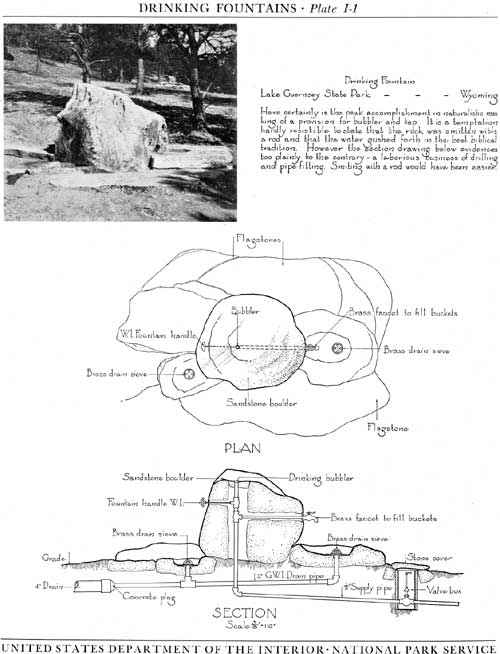
|
| Plate I-1 (click on image for a PDF version) |
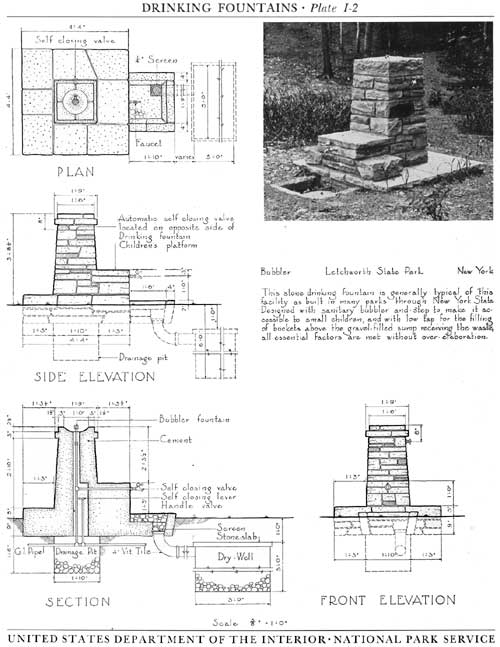
|
| Plate I-2 (click on image for a PDF version) |
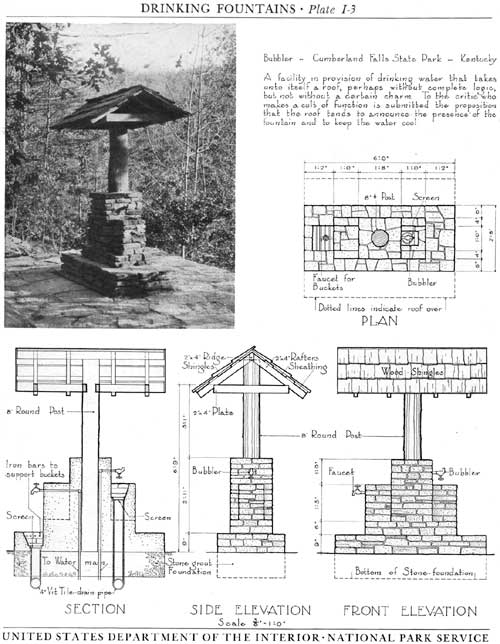
|
| Plate I-3 (click on image for a PDF version) |
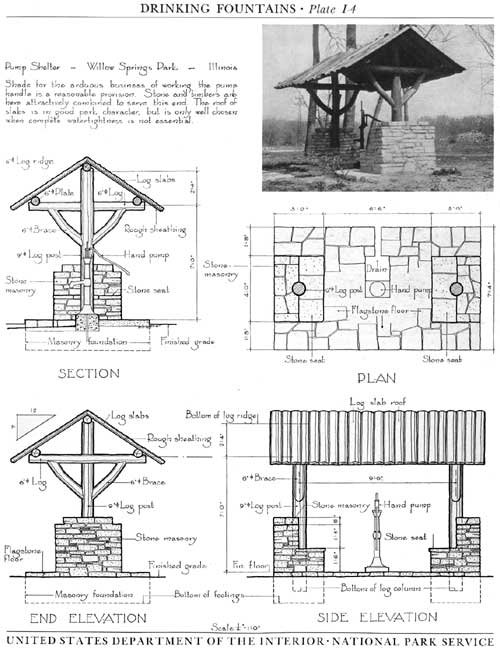
|
| Plate I-4 (click on image for a PDF version) |
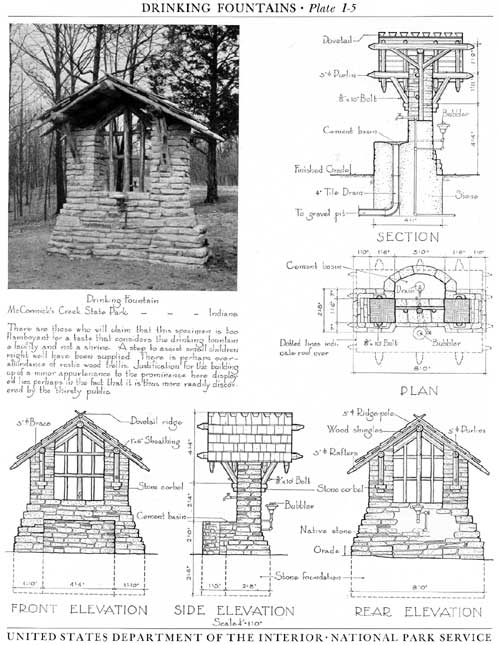
|
| Plate I-5 (click on image for a PDF version) |
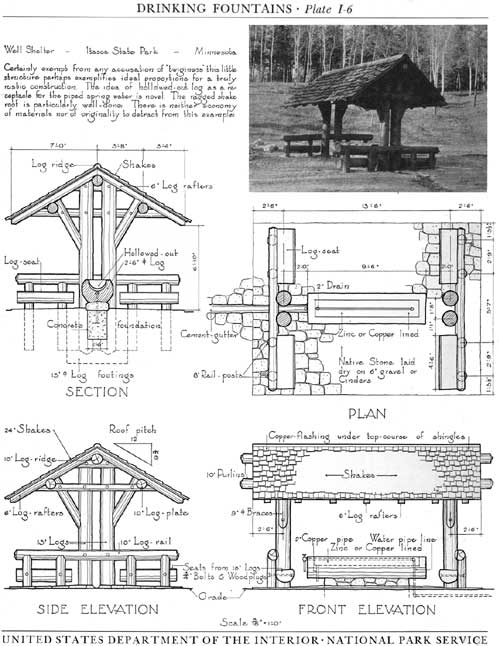
|
| Plate I-6 (click on image for a PDF version) |
Spring House, Boyle State Park, Arkansas
If a rustic structure may ever properly be termed a temple, here is one. A veritable shrine for a woodland spring, this shelter seems in every detail beyond legitimate criticism. Roof texture, "whittled" rafter ends, character of stone work—all combine to render a structural symphony. Even the almost invariably unpleasant perching of a log post upon a built-up rock base does not here seem an offense. Plans and details of the structure are shown on the opposite page.

|
| Plate I-7 (click on image for a PDF version) |
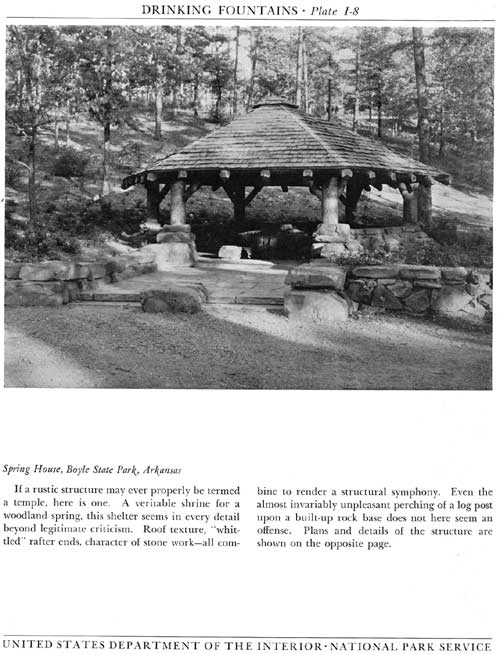
|
| Plate I-8 (click on image for a PDF version) |
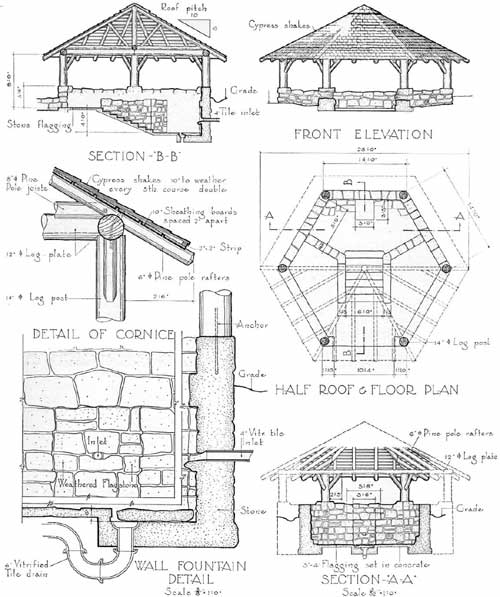
|
| Spring House, Boyle State Park, Arkansas |

|
| Spring House, Boyle State Park, Arkansas |
| <<< Previous | <<< Contents>>> | Next >>> |
park_structures_facilities/seci.htm
Last Updated: 5-Dec-2011